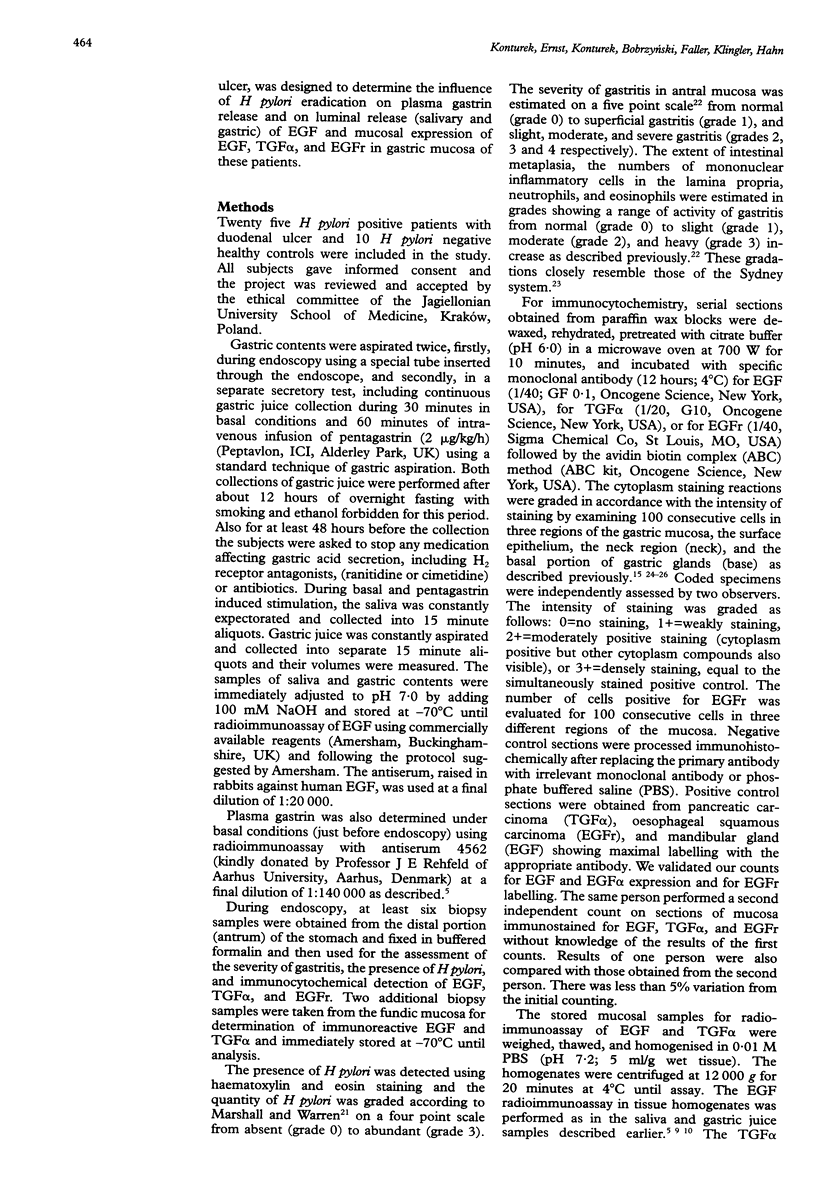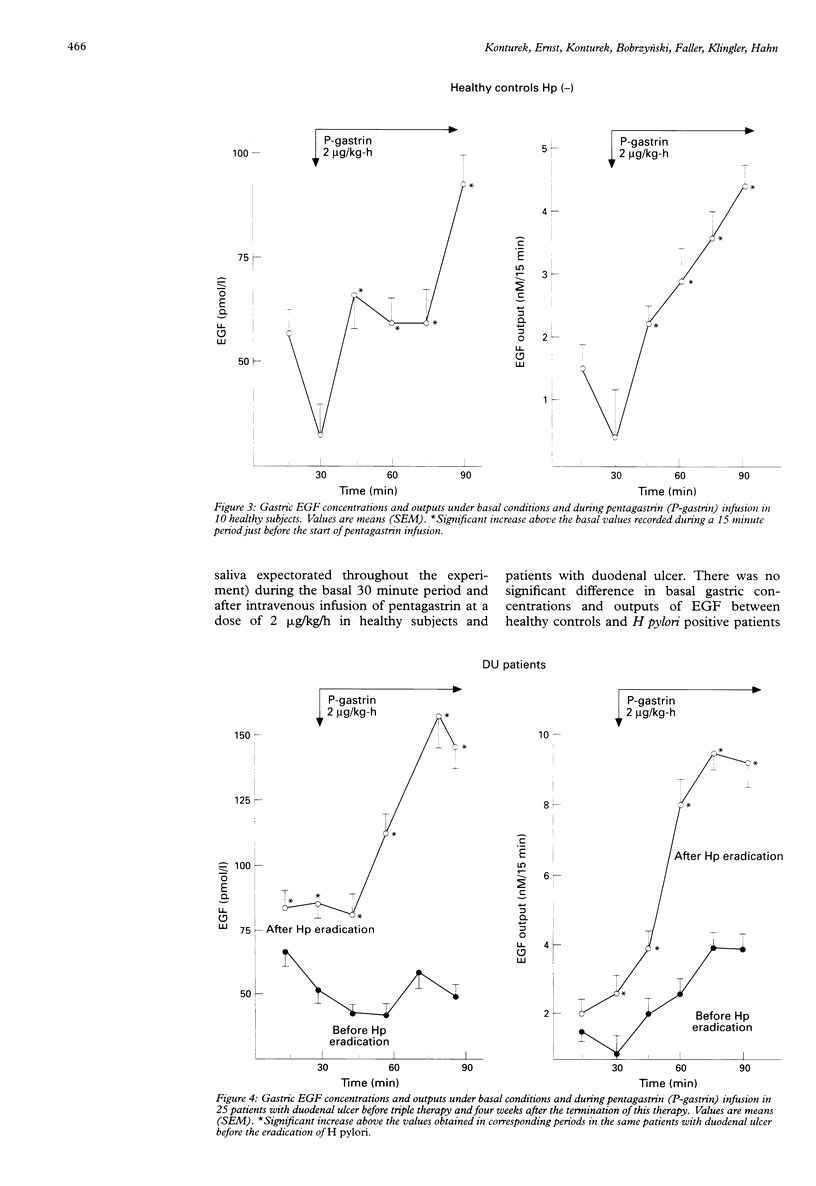Abstract
BACKGROUND: Epidermal growth factor (EGF) and transforming growth factor-alpha (TGF alpha) are potent gastric acid inhibitors and stimuli of mucosal growth and protection but their involvement in Helicobacter pylori associated duodenal ulcer has been little examined. AIM: To assess gastric acid secretion, plasma gastrin concentrations, mucosal content of EGF and TGF alpha, and mucosal expression of these peptides and their receptor (EGFr) as well as salivary and gastric luminal release of EGF under basal conditions and after pentagastrin stimulation in 10 healthy subjects and in 25 H pylori positive patients with duodenal ulcer before and after two weeks of triple anti-H pylori therapy and four weeks after the termination of this therapy. RESULTS: Pentagastrin stimulation caused a significant increase in salivary and gastric release of EGF both in healthy controls and patients with duodenal ulcers but in the patients, the eradication of H pylori resulted in several fold higher gastric luminal (but not salivary) EGF release than before the anti-H pylori therapy. Mucosal contents of immunoreactive EGF and TGF alpha and mucosal expression of EGF, TGF alpha, and EGFr in H pylori positive patients with duodenal ulcer were significantly higher than those in healthy H pylori negative controls and this increase persisted after eradication of H pylori. Basal plasma gastrin was significantly reduced after two weeks of triple therapy and four weeks after the H pylori eradication all ulcers were completely healed. CONCLUSIONS: (1) H pylori infection in patients with duodenal ulcer was accompanied by enhanced plasma gastrin and increased mucosal content and expression of TGF alpha, EGF, and EGFr; (2) H pylori eradication resulted in ulcer healing, reduction in plasma gastrin, and enhancement of gastric (but not salivary) luminal release of EGF, particularly after pentagastrin stimulation; and (3) enhanced mucosal content and expression of TGF alpha, EGF, and EGFr and increased luminal release of EGF may contribute to ulcer healing after eradication of H pylori.
Full text
PDF






Selected References
These references are in PubMed. This may not be the complete list of references from this article.
- Barnard J. A., Beauchamp R. D., Russell W. E., Dubois R. N., Coffey R. J. Epidermal growth factor-related peptides and their relevance to gastrointestinal pathophysiology. Gastroenterology. 1995 Feb;108(2):564–580. doi: 10.1016/0016-5085(95)90087-x. [DOI] [PubMed] [Google Scholar]
- Brzozowski T., Konturek P. C., Konturek S. J., Ernst H., Stachura J., Hahn E. G. Gastric adaptation to injury by repeated doses of aspirin strengthens mucosal defence against subsequent exposure to various strong irritants in rats. Gut. 1995 Dec;37(6):749–757. doi: 10.1136/gut.37.6.749. [DOI] [PMC free article] [PubMed] [Google Scholar]
- Brzozowski T., Konturek P. C., Konturek S. J., Ernst H., Stachura J., Hahn E. G. Gastric adaptation to injury by repeated doses of aspirin strengthens mucosal defence against subsequent exposure to various strong irritants in rats. Gut. 1995 Dec;37(6):749–757. doi: 10.1136/gut.37.6.749. [DOI] [PMC free article] [PubMed] [Google Scholar]
- COHEN S. Isolation of a mouse submaxillary gland protein accelerating incisor eruption and eyelid opening in the new-born animal. J Biol Chem. 1962 May;237:1555–1562. [PubMed] [Google Scholar]
- Cahill R. J., Xia H., Kilgallen C., Beattie S., Hamilton H., O'Morain C. Effect of eradication of Helicobacter pylori infection on gastric epithelial cell proliferation. Dig Dis Sci. 1995 Aug;40(8):1627–1631. doi: 10.1007/BF02212681. [DOI] [PubMed] [Google Scholar]
- Calabrò A., Orsini B., Brocchi A., Falchini M., Fedi P., Surrenti C. Gastric juice immunoreactive epidermal growth factor levels in patients with peptic ulcer disease. Am J Gastroenterol. 1990 Apr;85(4):404–407. [PubMed] [Google Scholar]
- Elder J. B., Williams G., Lacey E., Gregory H. Cellular localisation of human urogastrone/epidermal growth factor. Nature. 1978 Feb 2;271(5644):466–467. doi: 10.1038/271466a0. [DOI] [PubMed] [Google Scholar]
- Gregory H. Isolation and structure of urogastrone and its relationship to epidermal growth factor. Nature. 1975 Sep 25;257(5524):325–327. doi: 10.1038/257325a0. [DOI] [PubMed] [Google Scholar]
- Hansen G., Müller C., Sinha P., Bohnenkamp W., Köttgen E. Gastric ulcer is accompanied by a decrease of epidermal growth factor in gastric juice and saliva. J Clin Chem Clin Biochem. 1989 Sep;27(9):539–545. doi: 10.1515/cclm.1989.27.9.539. [DOI] [PubMed] [Google Scholar]
- Jankowski J., McMenemin R., Yu C., Hopwood D., Wormsley K. G. Proliferating cell nuclear antigen in oesophageal diseases; correlation with transforming growth factor alpha expression. Gut. 1992 May;33(5):587–591. doi: 10.1136/gut.33.5.587. [DOI] [PMC free article] [PubMed] [Google Scholar]
- Konturek J. W., Bielanski W., Konturek S. J., Bogdal J., Oleksy J. Distribution and release of epidermal growth factor in man. Gut. 1989 Sep;30(9):1194–1200. doi: 10.1136/gut.30.9.1194. [DOI] [PMC free article] [PubMed] [Google Scholar]
- Konturek J. W., Brzozowski T., Konturek S. J. Epidermal growth factor in protection, repair, and healing of gastroduodenal mucosa. J Clin Gastroenterol. 1991;13 (Suppl 1):S88–S97. doi: 10.1097/00004836-199112001-00015. [DOI] [PubMed] [Google Scholar]
- Konturek J. W., Gillessen A., Konturek S. J., Domschke W. Eradication of Helicobacter pylori restores the inhibitory effect of cholecystokinin on postprandial gastrin release in duodenal ulcer patients. Gut. 1995 Oct;37(4):482–487. doi: 10.1136/gut.37.4.482. [DOI] [PMC free article] [PubMed] [Google Scholar]
- Konturek P. C., Brzozowski T., Konturek S. J., Ernst H., Drozdowicz D., Pajdo R., Hahn E. G. Expression of epidermal growth factor and transforming growth factor alpha during ulcer healing. Time sequence study. Scand J Gastroenterol. 1997 Jan;32(1):6–15. doi: 10.3109/00365529709025056. [DOI] [PubMed] [Google Scholar]
- Konturek P. C., Brzozowski T., Konturek S. J., Ernst H., Drozdowicz D., Pajdo R., Hahn E. G. Expression of epidermal growth factor and transforming growth factor alpha during ulcer healing. Time sequence study. Scand J Gastroenterol. 1997 Jan;32(1):6–15. doi: 10.3109/00365529709025056. [DOI] [PubMed] [Google Scholar]
- Konturek P. C., Konturek S. J. Role of Helicobacter pylori infection in gastro-duodenal secretion and in pathogenesis of peptic ulcer and gastritis. J Physiol Pharmacol. 1994 Sep;45(3):333–350. [PubMed] [Google Scholar]
- Konturek S. J., Brzozowski T., Majka J., Dembinski A., Slomiany A., Slomiany B. L. Transforming growth factor alpha and epidermal growth factor in protection and healing of gastric mucosal injury. Scand J Gastroenterol. 1992 Aug;27(8):649–655. doi: 10.3109/00365529209000134. [DOI] [PubMed] [Google Scholar]
- Lee H., Hansson H. A., Norström E., Helander H. F. Immunoreactivities for epidermal growth factor (EGF) and for EGF receptors in rats with gastric ulcers. Cell Tissue Res. 1991 Aug;265(2):211–218. doi: 10.1007/BF00398069. [DOI] [PubMed] [Google Scholar]
- Levi S., Beardshall K., Haddad G., Playford R., Ghosh P., Calam J. Campylobacter pylori and duodenal ulcers: the gastrin link. Lancet. 1989 May 27;1(8648):1167–1168. doi: 10.1016/s0140-6736(89)92752-9. [DOI] [PubMed] [Google Scholar]
- Lynch D. A., Mapstone N. P., Clarke A. M., Jackson P., Dixon M. F., Quirke P., Axon A. T. Cell proliferation in the gastric corpus in Helicobacter pylori associated gastritis and after gastric resection. Gut. 1995 Mar;36(3):351–353. doi: 10.1136/gut.36.3.351. [DOI] [PMC free article] [PubMed] [Google Scholar]
- Marshall B. J., Warren J. R. Unidentified curved bacilli in the stomach of patients with gastritis and peptic ulceration. Lancet. 1984 Jun 16;1(8390):1311–1315. doi: 10.1016/s0140-6736(84)91816-6. [DOI] [PubMed] [Google Scholar]
- Ohmura E., Emoto N., Tsushima T., Watanabe S., Takeuchi T., Kawamura M., Shigemoto M., Shizume K. Salivary immunoreactive human epidermal growth factor (IR-hEGF) in patients with peptic ulcer disease. Hepatogastroenterology. 1987 Aug;34(4):160–163. [PubMed] [Google Scholar]
- Polk W. H., Jr, Dempsey P. J., Russell W. E., Brown P. I., Beauchamp R. D., Barnard J. A., Coffey R. J., Jr Increased production of transforming growth factor alpha following acute gastric injury. Gastroenterology. 1992 May;102(5):1467–1474. doi: 10.1016/0016-5085(92)91703-7. [DOI] [PubMed] [Google Scholar]
- Price A. B. The Sydney System: histological division. J Gastroenterol Hepatol. 1991 May-Jun;6(3):209–222. doi: 10.1111/j.1440-1746.1991.tb01468.x. [DOI] [PubMed] [Google Scholar]
- Thomas D. M., Nasim M. M., Gullick W. J., Alison M. R. Immunoreactivity of transforming growth factor alpha in the normal adult gastrointestinal tract. Gut. 1992 May;33(5):628–631. doi: 10.1136/gut.33.5.628. [DOI] [PMC free article] [PubMed] [Google Scholar]
- Thomsen L. L., Gavin J. B., Tasman-Jones C. Relation of Helicobacter pylori to the human gastric mucosa in chronic gastritis of the antrum. Gut. 1990 Nov;31(11):1230–1236. doi: 10.1136/gut.31.11.1230. [DOI] [PMC free article] [PubMed] [Google Scholar]
- Tunio A. M., Hobsley M. Epidermal growth factor in saliva and gastric juice: response to histamine. Gut. 1995 Sep;37(3):335–339. doi: 10.1136/gut.37.3.335. [DOI] [PMC free article] [PubMed] [Google Scholar]
- Unidentified curved bacilli on gastric epithelium in active chronic gastritis. Lancet. 1983 Jun 4;1(8336):1273–1275. [PubMed] [Google Scholar]
- Wright N. A., Pike C., Elia G. Induction of a novel epidermal growth factor-secreting cell lineage by mucosal ulceration in human gastrointestinal stem cells. Nature. 1990 Jan 4;343(6253):82–85. doi: 10.1038/343082a0. [DOI] [PubMed] [Google Scholar]


